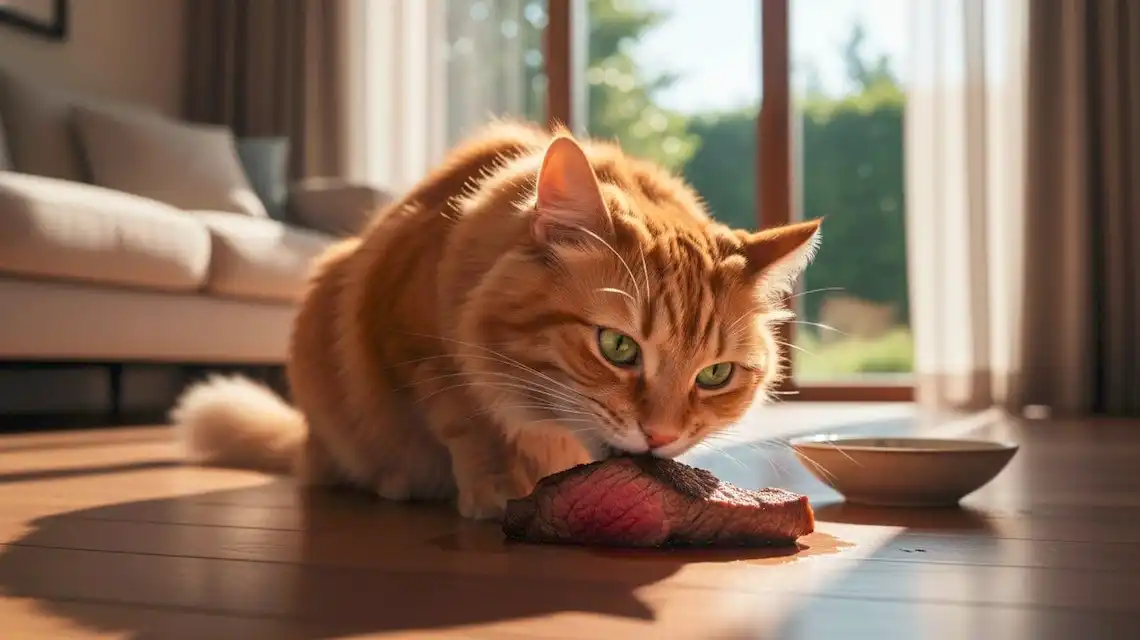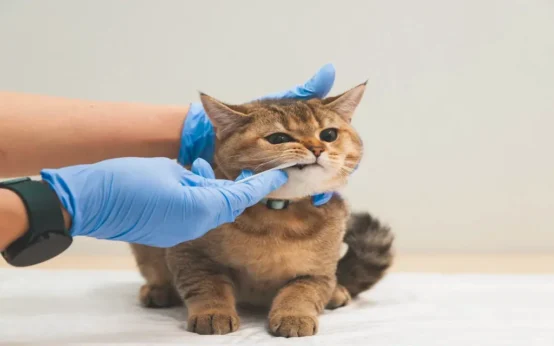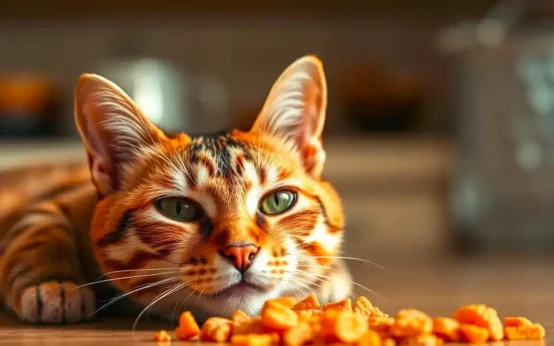Curious about can cats eat raw beef? Short answer, yes, some healthy adult cats can nibble a small amount once in a while. But there are real risks, and raw beef alone is not a complete diet.
Most vets urge caution due to bacteria, parasites, and nutrition gaps. If you decide to try it, keep it rare, tiny, and handled with care. This guide walks through the possible benefits, the bigger risks, safe prep steps, and simple alternatives that give beef flavor with less worry. You will learn how much is safe, which cuts to pick, what to avoid, and when to stop. By the end, you will have a clear, practical plan that puts your cat’s safety first.
Can Cats Eat Raw Beef? The Quick Answer and What Vets Recommend
Yes, some healthy adult cats can have a little raw beef as an occasional treat. It should be plain, lean, and served in tiny amounts. Raw beef should not be a main food because it is not complete or balanced for daily nutrition.
Most veterinarians and pet nutritionists recommend cooked options or complete commercial diets instead. The reason is simple. Raw meat can carry bacteria that make pets and people sick, and plain beef does not meet a cat’s full needs. A cat’s long-term diet must hit the right levels of protein, fat, minerals, and vitamins. Raw beef on its own comes up short.
Follow the 10 percent treat rule for daily calories. Treats, including raw beef, should make up less than 10 percent of your cat’s daily intake. That way, your cat still gets most nutrition from a balanced base diet.
Some homes should skip raw meat altogether. If you live with young kids, seniors, pregnant people, or anyone with a weak immune system, keep raw meats away from the kitchen and the litter box area. Cats can shed bacteria after eating raw food, which raises the risk for the whole family.
Bottom line, if you still want to try raw beef, do it sparingly, handle it like lab work, and talk with your vet first. For many cats, cooked beef or complete diets are safer choices.
How Much Raw Beef Is Safe as a Treat?
For an average 9 to 10 pound cat, offer 1 to 2 teaspoons of finely cut lean beef. Do this up to 1 to 2 times per week. Keep total treats under 10 percent of your cat’s daily calories.
Many indoor cats need about 180 to 220 kcal per day. One ounce of lean raw beef has roughly 55 to 70 kcal. That is too much for a single treat, so serve far less than an ounce.
Introduce new foods slowly. Try raw only in healthy adult cats with no stomach issues. If your cat has a sensitive gut or a medical condition, skip raw completely unless your vet approves.
Which Cuts of Beef Are Safer to Use?
Choose lean, whole-muscle cuts such as top round, sirloin, or eye of round. These are easier on the stomach and simpler to trim.
Avoid pre-ground beef, since grinding raises the risk of bacteria spread. Skip very fatty cuts that can trigger vomiting or diarrhea. Never offer seasoned, cured, or marinated meats. Deli meat and jerky often contain salt and additives, which are not safe for cats.
Use liver with care. Large amounts can cause vitamin A problems. If you want to include organ meats, do it only as part of a complete, vet-guided recipe.
Raw Beef for Cats: Benefits and Risks You Should Weigh
Raw beef can be tempting. Cats often love the aroma and texture. It provides high-quality animal protein and moisture, which helps with hydration. Some owners notice better appetite or more excitement at mealtime when a tiny raw treat is offered.
That said, the risks outweigh the benefits for many homes. Raw beef can carry Salmonella, E. coli, and Listeria. Even if your cat acts fine, bacteria can spread through saliva, food bowls, fur, and the litter box. People in the home can get sick from contact with surfaces or the cat.
Plain raw beef also falls short on nutrition. It lacks the right balance of calcium and phosphorus. May not supply enough taurine without careful planning. It can also miss key vitamins, including vitamin E and a proper B-complex balance. That is why most vets advise against DIY raw diets unless you work from a vetted recipe with a professional.
Some cats should never eat raw meat. Kittens, seniors, pregnant or nursing cats, and cats with chronic illnesses face higher risk. Cats on immune-suppressing drugs are also at risk. If your household includes high-risk people, skip raw beef entirely.
In short, a bite now and then can be safe for some, but safety steps matter. If you are unsure, choose cooked treats or complete diets that give similar taste with fewer hazards.
Possible Benefits of Raw Beef
- High-quality protein: Supports muscle maintenance in carnivores.
- Strong flavor and aroma: Can tempt picky eaters to engage with meals.
- Natural moisture: Helps daily hydration, especially for cats that skip water bowls.
- Feeding enrichment: Some cats show more interest and play during feeding time.
Proven gains for dental health or a better coat are limited when you feed only small amounts as treats.
Bacteria and Parasite Risks to Cats and People
Raw beef can carry Salmonella, E. coli, and Listeria. These pathogens can make both cats and people sick. Freezing may lower some parasite risks, but it does not reliably kill all bacteria.
Households with very young kids, pregnant people, elderly adults, or anyone with a weak immune system should avoid raw meat for pets. Cats can shed bacteria in saliva and stool after eating raw meat. That bacteria can reach kitchen counters, floors, and the litter box.
Nutrition Gaps With Plain Raw Beef
Plain raw beef does not meet AAFCO profiles for cats. The calcium to phosphorus ratio is poor without bones or a proper supplement. Taurine can be low if the diet is not designed. Vitamins may be missing, such as vitamin E, a balanced B-complex, and preformed vitamin A from safe portions of liver.
Avoid DIY raw diets unless you have a recipe from a board-certified veterinary nutritionist. Guessing at supplements, organs, or bones can harm your cat over time.
Cats Who Should Not Eat Raw Beef
- Kittens, seniors, or pregnant and nursing cats
- Cats with chronic disease, gut problems, or a history of pancreatitis
- Cats on immune-suppressing drugs or with weak immune systems
- Any cat living with high-risk people in the home
Talk with your veterinarian before any raw trial.
If You Choose to Feed Raw Beef, Do It Safely
You can lower risk with careful steps. Start with clean sourcing, strict prep, cold storage, and quick serving. Keep portions small and rare. Watch your cat’s behavior and stool after every trial. If anything looks off, stop right away and call your vet.
Keep raw meat tools separate from family dishes. Treat the process like you are handling raw chicken for people. A little extra care goes a long way in keeping your home safe.
Smart Buying, Prep, and Storage
- Buy human-grade, whole cuts the same day you plan to portion them.
- Trim visible fat and sinew. Cut pieces into pea-sized bits for easy chewing.
- Freeze single-serve portions right away. Label bags with date and amount.
- Thaw in the fridge, not on the counter. Cold slows bacterial growth.
- Serve cold or room temp. Discard leftovers after 30 minutes.
- Wash hands, knives, cutting boards, and bowls with hot soapy water.
- Keep raw meat tools and cat bowls separate from family prep items.
A Simple Two-Week Trial Plan
- Week 1: Offer 1 teaspoon once. Wait 48 hours and watch closely.
- If no vomiting or diarrhea, offer 1 teaspoon again later that week.
- Week 2: Repeat once or twice, still under the 10 percent treat limit.
- Stop if you see soft stool, lethargy, fever, or decreased appetite.
- Keep notes on stool, energy, and appetite so you can spot trends.
Bones, Choking, and Teeth Safety
Skip cooked bones. They can splinter and cause injuries. Raw bones also carry risks, such as choking and tooth fractures. For most house cats, bones are not worth it.
Offer small boneless pieces only. For dental health, daily brushing and vet cleanings work better and keep your cat safer.
Warning Signs After Feeding Raw Beef
Watch for vomiting, diarrhea, bloody stool, fever, belly pain, drooling, or sudden lethargy. Many foodborne illnesses appear within 6 to 72 hours after eating. If symptoms show up, stop raw meat and call your vet. Check the litter box and make sure your cat keeps drinking water.
Safer Alternatives to Raw Beef and Vet-Approved Options
You can give your cat beef flavor with far less risk. Plain cooked beef works well when used as a treat. Complete and balanced commercial diets offer stronger safety and nutrition. If your cat begs for beef, you have choices that fit a cautious approach.
Small changes can help your cat accept new foods without stress. Start slow and watch for any upset.
Cooked Beef for Cats: Simple and Safe
Cook small pieces of lean beef with no oil, salt, onion, or garlic. Boil, bake, or pan-sear lightly in a clean pan. For whole cuts, cook to an internal temperature around 145°F, then let it rest and cool.
Cut into tiny pieces before serving. Keep amounts small, the same 1 to 2 teaspoon guideline, and follow the 10 percent treat rule.
Complete Diets: Raw or Lightly Cooked Options
If you prefer a raw-style approach, pick an AAFCO complete and balanced commercial diet. Options include high pressure processed raw, freeze-dried raw that you rehydrate, or gently cooked diets. These products are designed to meet a cat’s needs and often use steps that lower pathogen risk.
Ask your veterinarian or a board-certified nutritionist for brand and formula guidance. Choose a recipe that fits your cat’s age, weight, and health status.
Better Treat Ideas With Less Risk
- Freeze-dried single-ingredient beef treats from reputable brands
- Plain cooked chicken or turkey bits, in tiny portions
- A spoon of high-protein wet food used as a topper
Keep treats under 10 percent of daily calories. Read labels and skip products with salt, onion, garlic, or spices.
How to Switch Foods Without Upsetting Your Cat
Mix a small amount of the new food into the current diet over 5 to 7 days. Increase the new portion slowly while you watch appetite and stool. If your cat has loose stool or stops eating, pause the change. Go back one step for a few days, then try again.
Conclusion
Small amounts of raw beef can work as a rare treat for some healthy adult cats, but the safety and nutrition gaps are real. Keep treats under 10 percent of daily calories, follow strict hygiene, and skip raw entirely in high-risk homes. Cooked beef and complete, balanced diets are safer ways to satisfy a beef-loving cat.
Before trying raw, have a quick chat with your vet to review your cat’s health and history. If you decide to try it, start tiny, track how your cat feels, and stop at the first sign of trouble. Your cat’s well-being comes first, and smart choices today pay off for years.
Related post:
Raw Beef for Cats: Frequently Asked Questions
Can cats eat raw beef?
Yes, in small amounts, if it is fresh and handled safely. Raw beef can carry bacteria or parasites, so there is real risk. Many vets prefer cooked or commercial raw diets tested for safety.
Is raw beef safe for daily feeding?
Not on its own. Plain beef does not meet full nutrition needs. It lacks calcium, some vitamins, and trace minerals. A complete raw diet must be balanced with organs, bone or a calcium source, and supplements, ideally under a vet’s guidance.
What are the health risks?
Foodborne illness is the main concern. Salmonella, E. coli, and Toxoplasma can make cats sick, and they can spread to people. Signs include vomiting, diarrhea, fever, drooling, and low energy.
Which cats should avoid raw beef?
Kittens, seniors, pregnant or nursing cats, and any cat with a weak immune system. Also avoid it for cats with pancreatitis, inflammatory bowel disease, or chronic kidney disease unless a vet oversees the diet.
Is raw beef more nutritious than cooked?
Raw beef keeps more taurine than overcooked meat, but the difference is minor if the diet is balanced. Safety matters more. Light cooking on the outside lowers surface bacteria with little nutrient loss.
What cut of beef is best?
Choose lean, fresh, human‑grade whole cuts, like top round or sirloin. Avoid ground beef, it has a higher risk of contamination because more surface area gets exposed during processing.
How much raw beef can I offer?
As an occasional treat, limit to about 1 to 2 teaspoons for an average adult cat. For frequent feeding, the total diet must be balanced for calories and nutrients. Ask your vet for exact amounts.
Can I give raw beef bones?
Only raw, meaty bones sized to prevent swallowing whole, and only with supervision. Bones can crack teeth or cause blockages. Never feed cooked bones, they splinter.
What about fat and gristle?
Trim excess fat. Too much fat can trigger stomach upset or pancreatitis in sensitive cats. Skip gristle and large connective tissue pieces that are hard to chew.
Can freezing make raw beef safe?
Freezing can reduce some parasites, especially if held at very low temperatures for several days. It does not reliably kill bacteria. Use fresh product, keep it cold, and practice careful handling.
How do I prepare and store it safely?
- Thaw in the fridge, not on the counter.
- Keep separate cutting tools for raw meat.
- Wash hands and surfaces with hot, soapy water.
- Refrigerate portions and use within 24 to 48 hours.
- Discard leftovers that sat out for more than 30 minutes.
Can I season the meat?
No. Skip salt, garlic, onion, sauces, and marinades. Garlic and onion are toxic to cats. Plain, unseasoned meat only.
Will raw beef cause worms?
Beef can carry parasites, though it is less common than in some other meats. Sourcing, freezing, and hygiene reduce risk, but do not remove it. Keep your cat on a vet‑recommended deworming schedule.
How do I switch a cat to a raw diet?
Go slow. Start with tiny amounts mixed into their regular food and watch for loose stools or vomiting. If you see issues, stop and contact your vet. A full raw plan should be designed with a veterinary professional.
What signs mean my cat is not tolerating raw beef?
Repeated vomiting, diarrhea, straining, blood in stool, low appetite, drooling, fever, or belly pain. If you see any of these, seek vet care right away.
Is store‑bought raw cat food safer than DIY raw beef?
Commercial raw foods that meet AAFCO standards and use pathogen‑control steps offer more predictability. Still, they carry some risk. Read labels, check recalls, and handle them like any raw meat.
Can I balance a raw diet with only beef and supplements?
It is hard to do well without training. A proper raw plan uses a mix of proteins, organs, and a calcium source, with precise amounts of taurine, vitamin E, iodine, copper, manganese, and more. Get a recipe from a board‑certified nutritionist or your vet.
Is a lightly cooked beef diet a good compromise?
Often yes. Lightly cooked diets lower pathogen risk and can be balanced to meet full nutrition needs. Many cats accept them well.
Bottom line?
Small amounts of fresh, plain raw beef can be okay for healthy adult cats, but there are safety and nutrition gaps. If you want raw long term, work with your vet to build a complete and safe plan.




 Dog Trick Training for Beginners
Dog Trick Training for Beginners  Gingivitis Cats Symptoms Every Pet Parent Should Know
Gingivitis Cats Symptoms Every Pet Parent Should Know  How to Make Dog Cookies at Home
How to Make Dog Cookies at Home  Wet Food or Dry Food for Cats?
Wet Food or Dry Food for Cats?  What Is the Healthiest Hamster Breed for Your Home?
What Is the Healthiest Hamster Breed for Your Home?  Cat Food Intolerance Symptoms: How To Spot Them Early
Cat Food Intolerance Symptoms: How To Spot Them Early